
A well-traveled man from Austria once visited the village of Winter Harbour and said it was one of the last of its kind in the world. With few residents and so much to experience, this unique fishing village on the edge of the Pacific Ocean in remote northern Vancouver Island is a place you need to visit to appreciate.
Winter Harbour got its name in the 1800s when its sheltered harbour became a haven for sailing ships. Today, the busy docks provide modern fishing boats and adventurers with the same welcome respite.
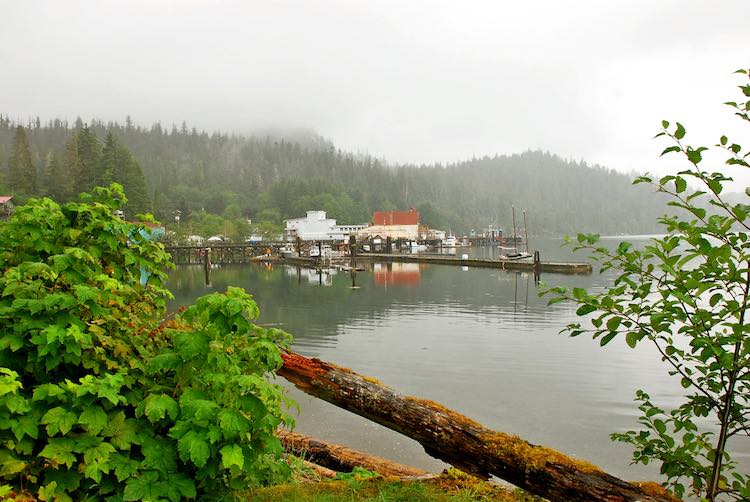
A Winter Harbour Morning
Until the 1990s, Winter Harbour was a hub for commercial fishing, with more than 700 boats using the docks and fish-buying station, as well as buying fuel and refilling ice. There was a schoolhouse, hundreds of residents, two general stores, a local logging camp, and plenty of parties! When the commercial fishery declined significantly, most of the residents moved away and the commercial boats mostly stopped coming. It took a few years for the sport fishermen to discover the area, but once they did, it quickly became well-known for both the quantity and variety of fish in its waters.
Where Is Winter Harbour?
Driving north on Highway 19, beyond Campbell River and through Port McNeill, visitors will find the road less traveled. The gravel road from Port Hardy to Winter Harbour is navigable
in any vehicle with good tires, and it’s well worth the effort and adventure. Many boaters choose to turn off before Port Hardy and take the 15-minute drive to Coal Harbour to launch. Anglers can leave their trailers there at reasonable rates and drive around to meet the boat in Winter Harbour. People also fly in from Port Hardy or further south on a floatplane. If you do this, be sure to arrange transport with your host in Winter Harbour since most accommodations are not in walking-distance.
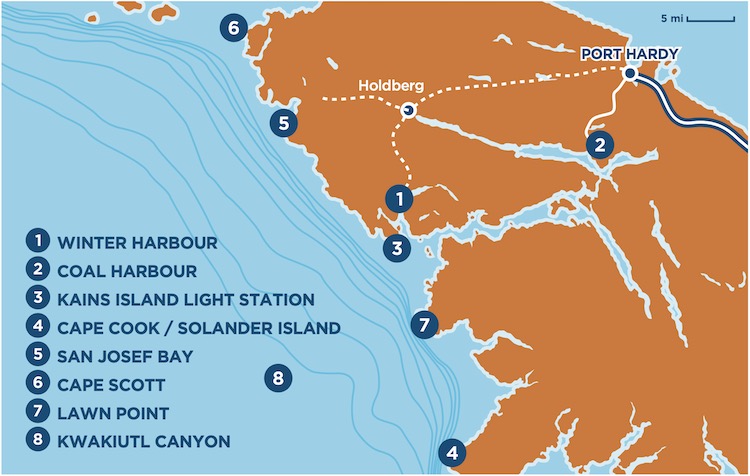
Winter Harbour Map
You may think of life in this remote village as mundane and predictable, but Winter Harbour locals will tell you there is never the same day twice. Visitors and residents keep things interesting, and there are always stories to be heard on the steps of the General Store and around the fuel dock. There’s plenty of wildlife action in the harbour, including eagles, black bears, deer, whales, sea otters, and so much more! Coast Guard and Navy ships often drop in for an overnight stay during their patrols, and Winter Harbour is one of the stops on the bi-annual Van Isle 360 sailing race.
The seaside wooden boardwalk used to be the only transportation route to get around the village before the main road was introduced. It remains today as a fantastic way to view the harbour, meet locals and visitors, and experience the town’s rich history. Be sure to stop by the community building where you’ll find the post office and Winter Harbour Museum, all run by locals who know the area well.
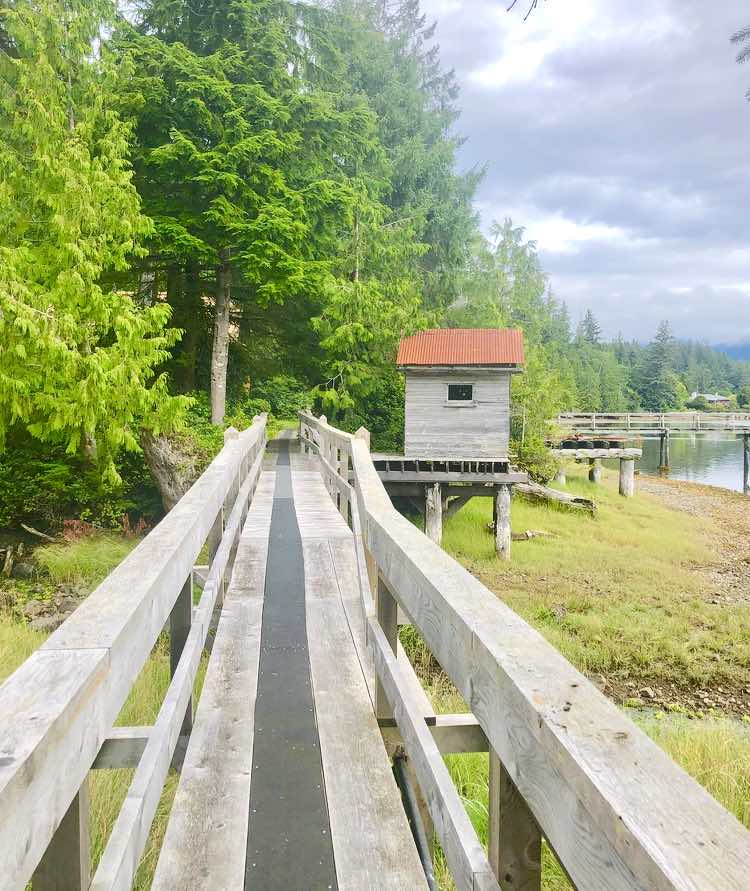
Winter Harbour Boardwalk
You can explore some of the most beautiful and remote beaches just minutes from the harbour. Grant Bay and San Josef Bay are just two that are absolutely worth the drive and hike. There are also great walks and hikes nearby like the Botel Trail, taking you through old growth forest and giant cedars.
There is very little commercial activity in Winter Harbour these days, but the Outpost General Store has pretty much everything you would need. From fishing gear to liquor, logo wear to groceries and snacks, this store is well stocked and always ready to help. You will often find fishermen at the end of the day, perched on the store’s beautiful deck, looking out at the boats coming in, sharing stories from the day and a good laugh. The Outpost also is home to the only fuel dock in the area, and they’re open every day with gas and diesel.
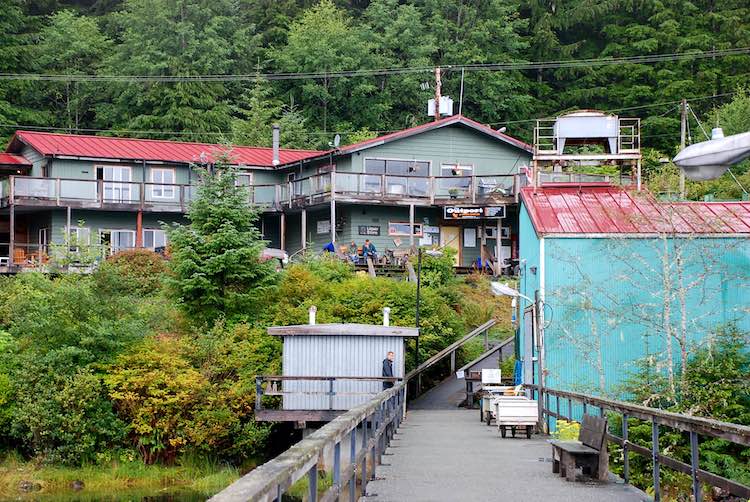
Outpost at Winter Harbour
There are a number of things that make Winter Harbour and the surrounding area so special for both visiting and fishing. The sheer remoteness, unspoiled biodiversity, and natural beauty are obvious, but arguably the most unique and defining aspect is the complexity of the area’s topography. This unique geography makes Winter Harbour
and Quatsino Sound a story of three fisheries—the inshore fishery, within the mouth and confines of Quatsino Fjord itself; the nearshore fishery, to the north and south along the rugged coast within a few miles from shore; and the offshore fishery, 4-6 miles offshore at the edge of the continental shelf and beyond to the offshore canyons.
Quatsino Sound
Quatsino Sound itself is a large deep fjord whose mouth faces the open Pacific Ocean to the west and nearly dissects the northern tip of Vancouver Island to the east. What makes the whole area particularly unique and productive is the fact that the edge of the continental shelf is so close to shore along this stretch of coast. In fact, the infamous “salmon highway” or “50-fathom edge” is on average only five nautical miles from shore along most of the coast stretching from Cape Cook up to Cape Scott. An angler can leave the shelter and comfort of Winter Harbour and be fishing the highway in 300′ to 325′ of water after a short 5- to 6-nautical mile jaunt—quite different from the likes of La Perouse
or Swiftsure Banks to the south, where anglers regularly travel 25 to 30 nautical miles to the same highway.
What makes the proximity of the 50-fathom edge and the related inshore shallows so good? Every old salt has their theory, but there is no denying the fact that cold, nutrient- rich water wells up annually from the deep offshore waters and is pushed up onto the relative shallows and structure of the continental shelf. This cold, rich water settles into the shallows and attracts and holds massive schools of bait such as herring, sardine, needlefish, and squid, which in turn brings in all of the larger pelagic species and bottom dwellers that are prized by anglers. Here’s a fun bit of trivia: The annual upwelling of cold water dubbed “the bulge” is actually measurable by satellite. In some areas nearby, the water is said to have been recorded up to 18” higher than surrounding water as a result of the current pushing up from below!
Every year, as salmon originating from a multitude of rivers to the south return from their feeding grounds well offshore, they quite reliably gather and travel along this relatively narrow stretch of water that seems to have the ideal combination of temperature, salinity, clarity, and feed. The highway brings the fish into the nearshore shallows, where they hold and feed on the large schools of bait.
This is precisely what made Winter Harbour such a renowned mecca for the commercial salmon fleet dating back to the 1940s, and why fish buyers and processors like JS MacMillan, Canfisco, and others built their bases in Winter Harbour proper. DFO restrictions shut down the majority of the commercial fishery in 1997. Since then Winter Harbour has largely transitioned to sport and recreational fishery, save for a few remaining commercial diehards. If there is an opening, it isn’t unusual to see 20- odd trollers tacking back and forth along the 50-fathom edge, but those days are now very few and far between.
While the commercial fishery was largely focussed on the offshore runs, the Quatsino fjord itself has many significant streams and rivers feeding into it, notably the Marble and Mahatta rivers, known for their Chinook and coho returns, respectively.
Each season, salmon returning to these local rivers congregate in the approaches of the sound, attracted by the plentiful bait and waiting for the flush of fresh water brought on by the rains. This gives anglers ample opportunity to fish the sheltered and generally calm waters in the mouth of the sound. In general, areas such as Kains Island Light Station, Macallister Rock, Gooding and Harvey Coves, and Cliffe Point are very good every spring and summer and are suitable for smaller vessels. Most of the best spots are within a few hundred yards of shore in less than 100 feet of water.
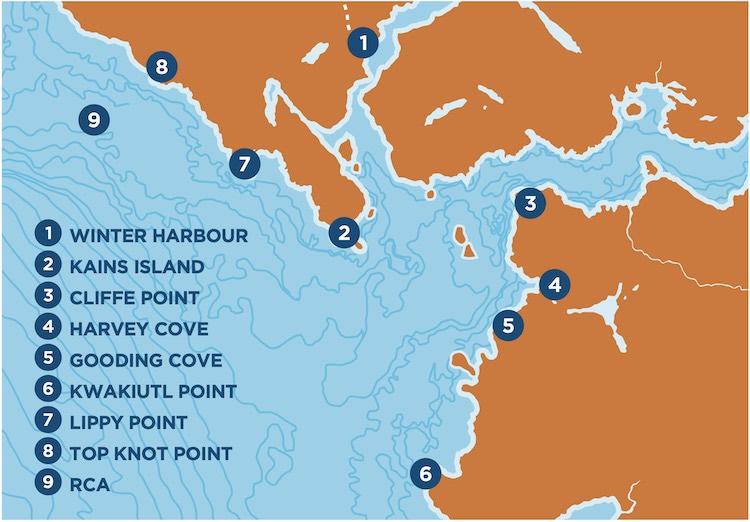
Winter Harbour Fishing
Halibut, Lingcod, and Rockfish
Despite the phenomenal salmon fishing, Winter Harbour has arguably become better known for the incredible abundance of halibut, lingcod, and variety of rockfish. Most Winter Harbour first- timers ask the same question: “Hey, can you tell me where to go for some hali or lings?” The answer? “Almost anywhere!”
The area’s nearshore structure extends miles to the north and south. Large sand/gravel flats and rocky pinnacles and outcroppings are everywhere. One can head south nearshore and follow the structure extending off Kwakiutl and Lawn Points and into the incredible beauty of Brooks Bay to Cape Cook and Solander Island. Or you can turn north towards the very popular grounds off Lippy Point and Top Knot, while the most adventurous head up to San Josef off the Scott Islands and the northernmost point of Vancouver Island. All of this diverse structure is known for abundant halibut, ling, and rockfish.
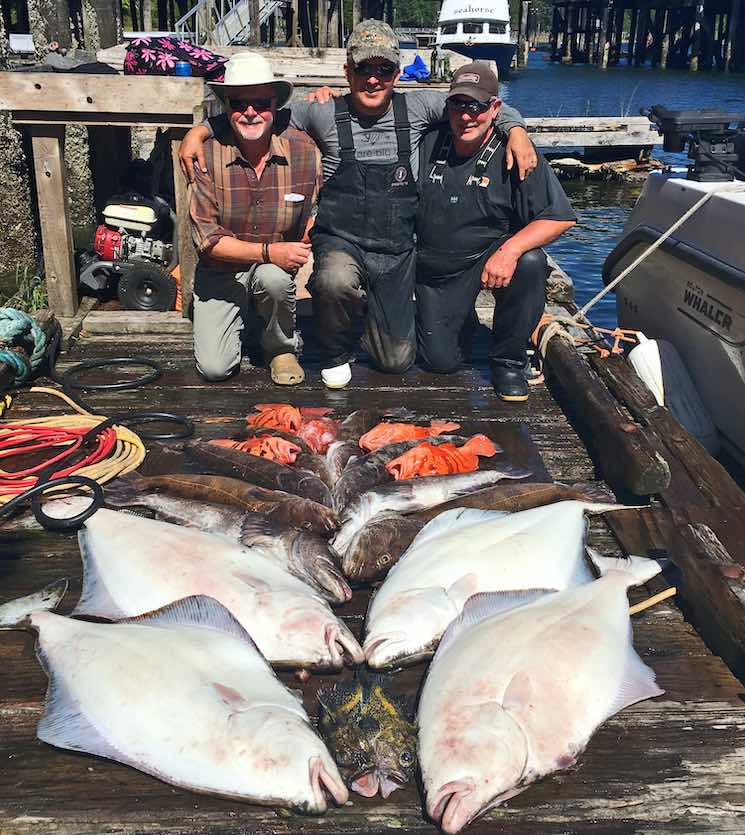
Winter Harbour Fishing
The prevailing summer weather is similar to most of the west coast of Vancouver Island. Sunny weather is usually a function of high pressure, which typically brings relative calm to the mornings, with north westerlies building throughout the day. A forecast for south- east winds is usually a forebearer of low pressure and precipitation, so that’s the one that we all pay close attention to. Captain Cook appropriately dubbed Brooks Peninsula “the Cape of Storms,” and it’s known for literally having its own weather system. It’s not unusual in the fall and winter for winds to blow SE 100 knots at Solander Island, with associated 10- to 15-meter seas. The infamous Nahwitti Bank to the north, near Cape Scott, is known to have some of the largest recorded waves in the world. Fortunately, it’s very rare to see these deep cyclonic lows in spring or summer, but as always, respect is warranted. The fact is, most days are surprisingly benign and beautiful.
How To Fish Winter Harbour
Similar to fishing many large areas, Winter Harbour is like one big puzzle. The absolute simplest, tried-and-true approach is to find the baitfish. Some of the best fisherman year in and year out follow the same approach as the old commercial highliners. Head to Kains Island Light Station, and set a course south-southwest. Drop your lines when you reach about 200′ of water depth. Most anglers test the waters with a 145′ line and a 185′ line and then head deeper until you get a fish or see evidence of feed. The vast majority of guides in the area use hoochies or spoons. Usually there are too many coho around to use bait offshore. Once you find the right depth, turn north or south depending on wind/weather and tide, follow the same contour, noting water temperature, and fish the little pockets of structure along the edge.
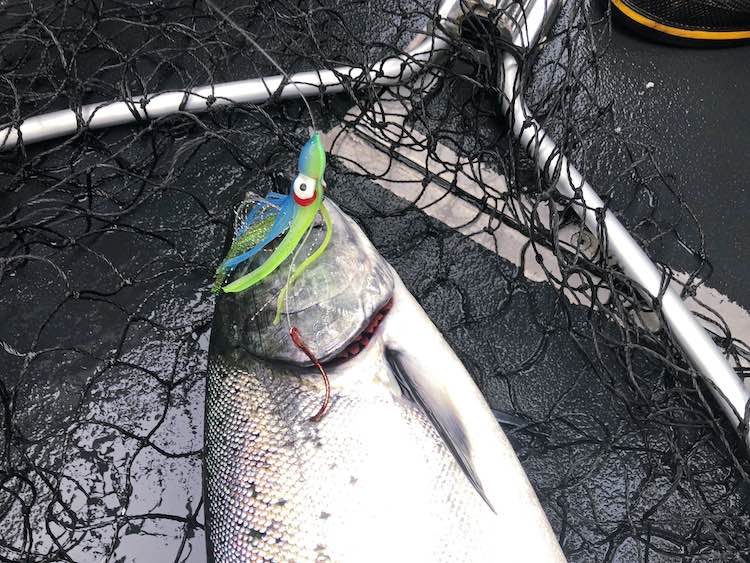
Once you have a few springs or coho in the boat, move to slightly shallower waters and pick the closest gravel humps or structure and drop some hali jigs. You really don’t need to be fishing any deeper than 200′. A simple herring/spreader bar setup seems to be the most reliable. Just let the tide drift you across the structures, bouncing on the bottom, and with some patience, you should get some action.
Like much of the beautiful west coast, the entire Winter Harbour/Quatsino area is rugged, windblown, and wild. The area is really a sight to behold, particularly on the those eerily calm, warm summer days where you can see so much moving on the water’s surface. You realize just how prolific the biosystem is in these remote open waters. It’s virtually a daily occurrence to see humpback whales feeding or travelling, or a large school of porpoises frolicking. As warm water has consistently moved into the area in recent years, it’s not unusual to see blue sharks or giant sunfish cruising along the surface, or giant albatross effortlessly gliding a few feet above the water.
Winter Harbour Tuna Fishing
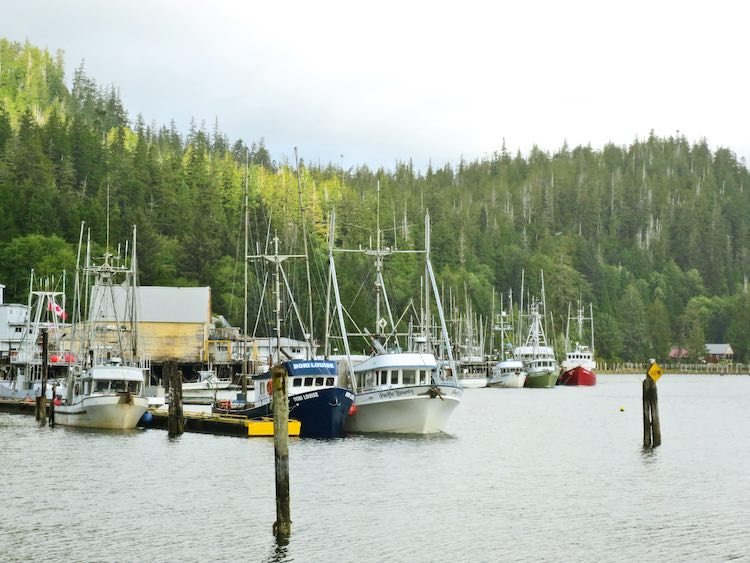
Winter Harbour Tuna Fleet
Each year seemingly brings more and more warm water from the south. It’s fairly commonplace now for 50 or more commercial boats to be working 20-40 nautical miles offshore fishing albacore tuna. More and more sport anglers are coming to the area specifically to target albacore. In the past few years, the very warm “ blue water” has come to within 15-25 nautical miles of shore straight out from Kains Light Station to Kwakiutl Canyon, making this a viable adventure for more and more anglers. Typical spring/summer water temperature is in the 12° to 13°C range, and during most recent years the blue water has reached 18°C!
One of the true joys of the area in general is the lack of traffic on the water, though more and more people are making the trek to this hidden gem. Whether you are looking for a guided trip, bringing your own boat or RV, or even pitching a tent, opportunities abound for virtually everyone. And without a doubt, the prize is worth the effort!
Winter Harbour Fishing Report
Local Facilities
Shops/Fuel
The Outpost Winter Harbour Greg & Andrea Vance | 250-969-4333
Post Office and Museum 250-969-4374
Fishing Charters
Brooks Bay Charters Rob Knutson | 800-960-2646
Larry’s Fishing Charters Larry Chudek | 250-969-4414
Oli’s Sportfishing Glen Olson | 250-640-5182
Reel Crazy Fishing Charters Steve Mawdsley | 250-217-6046
Wayne Ridley Charter and Accommodation Wayne Ridley | 604-792-4268
Camping/Moorage
The Outpost Winter Harbour Greg & Andrea Vance | 250-969-4333
Winter Harbour Marina & RV Hank Zacharias | 250-969-4325
Bed & Breakfast
Dick’s Last Resort B&B Dick Robinson | 250-969-4240
Food
Be More Pacific Eatery Cindy and Mike Lawrence | 250-969-4361
Scarlet Ibis Pub (Holberg) Pat Wynne | 250-288-3386
Visit the Store
$34.99
$34.99
Featured Catch

Joel Unickow halibut (Photo: Rob Frawley Lucky Strike Sportfishing Tofino)







